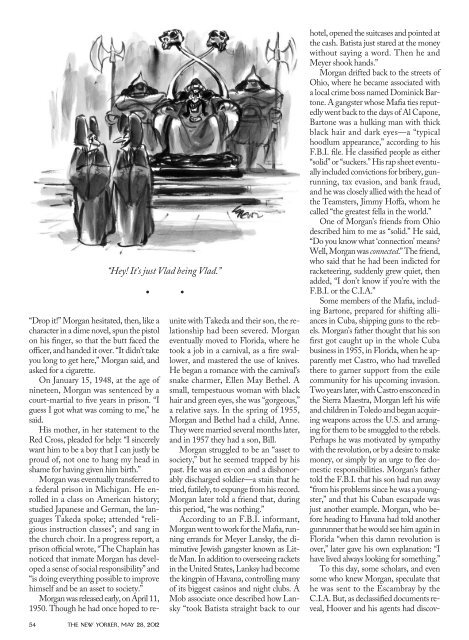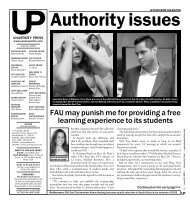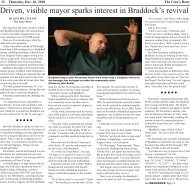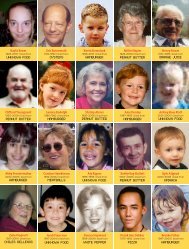THE YANKEE COMANDANTE
THE YANKEE COMANDANTE
THE YANKEE COMANDANTE
Create successful ePaper yourself
Turn your PDF publications into a flip-book with our unique Google optimized e-Paper software.
“Hey! It’s just Vlad being Vlad.”<br />
• •<br />
“Drop it!” Morgan hesitated, then, like a<br />
character in a dime novel, spun the pistol<br />
on his finger, so that the butt faced the<br />
officer, and handed it over. “It didn’t take<br />
you long to get here,” Morgan said, and<br />
asked for a cigarette.<br />
On January 15, 1948, at the age of<br />
nineteen, Morgan was sentenced by a<br />
court-martial to five years in prison. “I<br />
guess I got what was coming to me,” he<br />
said.<br />
His mother, in her statement to the<br />
Red Cross, pleaded for help: “I sincerely<br />
want him to be a boy that I can justly be<br />
proud of, not one to hang my head in<br />
shame for having given him birth.”<br />
Morgan was eventually transferred to<br />
a federal prison in Michigan. He enrolled<br />
in a class on American history;<br />
studied Japanese and German, the languages<br />
Takeda spoke; attended “religious<br />
instruction classes”; and sang in<br />
the church choir. In a progress report, a<br />
prison official wrote, “The Chaplain has<br />
noticed that inmate Morgan has developed<br />
a sense of social responsibility” and<br />
“is doing everything possible to improve<br />
himself and be an asset to society.”<br />
Morgan was released early, on April 11,<br />
1950. Though he had once hoped to reunite<br />
with Takeda and their son, the relationship<br />
had been severed. Morgan<br />
eventually moved to Florida, where he<br />
took a job in a carnival, as a fire swallower,<br />
and mastered the use of knives.<br />
He began a romance with the carnival’s<br />
snake charmer, Ellen May Bethel. A<br />
small, tempestuous woman with black<br />
hair and green eyes, she was “gorgeous,”<br />
a relative says. In the spring of 1955,<br />
Morgan and Bethel had a child, Anne.<br />
They were married several months later,<br />
and in 1957 they had a son, Bill.<br />
Morgan struggled to be an “asset to<br />
society,” but he seemed trapped by his<br />
past. He was an ex-con and a dishonorably<br />
discharged soldier—a stain that he<br />
tried, futilely, to expunge from his record.<br />
Morgan later told a friend that, during<br />
this period, “he was nothing.”<br />
According to an F.B.I. informant,<br />
Morgan went to work for the Mafia, running<br />
errands for Meyer Lansky, the diminutive<br />
Jewish gangster known as Little<br />
Man. In addition to overseeing rackets<br />
in the United States, Lanksy had become<br />
the kingpin of Havana, controlling many<br />
of its biggest casinos and night clubs. A<br />
Mob associate once described how Lansky<br />
“took Batista straight back to our<br />
hotel, opened the suitcases and pointed at<br />
the cash. Batista just stared at the money<br />
without saying a word. Then he and<br />
Meyer shook hands.”<br />
Morgan drifted back to the streets of<br />
Ohio, where he became associated with<br />
a local crime boss named Dominick Bartone.<br />
A gangster whose Mafia ties reputedly<br />
went back to the days of Al Capone,<br />
Bartone was a hulking man with thick<br />
black hair and dark eyes—a “typical<br />
hoodlum appearance,” according to his<br />
F.B.I. file. He classified people as either<br />
“solid” or “suckers.” His rap sheet eventually<br />
included convictions for bribery, gunrunning,<br />
tax evasion, and bank fraud,<br />
and he was closely allied with the head of<br />
the Teamsters, Jimmy Hoffa, whom he<br />
called “the greatest fella in the world.”<br />
One of Morgan’s friends from Ohio<br />
described him to me as “solid.” He said,<br />
“Do you know what ‘connection’ means?<br />
Well, Morgan was connected.” The friend,<br />
who said that he had been indicted for<br />
racketeering, suddenly grew quiet, then<br />
added, “I don’t know if you’re with the<br />
F.B.I. or the C.I.A.”<br />
Some members of the Mafia, including<br />
Bartone, prepared for shifting alliances<br />
in Cuba, shipping guns to the rebels.<br />
Morgan’s father thought that his son<br />
first got caught up in the whole Cuba<br />
business in 1955, in Florida, when he apparently<br />
met Castro, who had travelled<br />
there to garner support from the exile<br />
community for his upcoming invasion.<br />
Two years later, with Castro ensconced in<br />
the Sierra Maestra, Morgan left his wife<br />
and children in Toledo and began acquiring<br />
weapons across the U.S. and arranging<br />
for them to be smuggled to the rebels.<br />
Perhaps he was motivated by sympathy<br />
with the revolution, or by a desire to make<br />
money, or simply by an urge to flee domestic<br />
responsibilities. Morgan’s father<br />
told the F.B.I. that his son had run away<br />
“from his problems since he was a youngster,”<br />
and that his Cuban escapade was<br />
just another example. Morgan, who before<br />
heading to Havana had told another<br />
gunrunner that he would see him again in<br />
Florida “when this damn revolution is<br />
over,” later gave his own explanation: “I<br />
have lived always looking for something.”<br />
To this day, some scholars, and even<br />
some who knew Morgan, speculate that<br />
he was sent to the Escambray by the<br />
C.I.A. But, as declassified documents reveal,<br />
Hoover and his agents had discov-<br />
54 <strong>THE</strong> NEW YORKER, MAY 28, 2012









